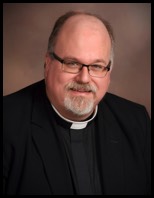The Imprint of God
By: Dr. Gregory S. Neal

Then I met her. I looked at this tiny, white-haired, scruffy-looking fuzz-ball Chihuahua and I thought to myself: “Oh, no.” I took that little puppy into my arms, sat down on the couch, and as it burrowed its sweet little face right into my armpit, I knew I was gone. We didn't adopt that dog - she adopted us! “Mine!” she said as she claimed me as her human. We eventually named her Chloe, but at first we called her “Miss Munchkin,” and that term of endearment has stuck with her.
One evening, while she was sleeping in my arms as I sat on the couch, I needed to go to the bathroom; by this time, I had learned that we just couldn’t put her down: she would squeak and, if left alone for too long, would start to cry and then bark. So, continuing to hold her in my arms, I carried her with me to the hallway bathroom. As I entered the room this little dog caught sight of herself in the mirror and was instantly transformed from a sweet little angel into a vicious little monster: she growled and barked and tried to leap out of my arms at the little dog she saw in the mirror. At first, she didn’t know it was herself.
I remember the first time I saw myself on camera. Do any of you remember Bozo the Clown? Back in the early 1970s Bozo was at a public appearance in Dallas, Texas; TV cameras were going to be there, and I had begged Mom to take me because I wanted to meet Bozo. I remember that the crowd was large, kids were screaming, and I was worried I wouldn’t be able to get close to Bozo. But, Mom led me through the crowd and right up to that Clown; I looked up at Bozo, and Bozo looked down at me, and I remember being so absolutely terrified that I opened my mouth and screamed my head off. Later that day, after we got home and I saw the footage on TV, I remember how confused I was because I didn’t recognize myself. I saw the clown; I saw my mother; but that screaming little boy couldn’t be me … could it? I was used to seeing myself in the mirror, and that boy on the TV didn’t look like me! I knew what I looked like because I’d seen myself many times in a mirror, and that kid on the tube wasn’t me! Was it? Yes, our reflections are weird things: they mirror what we look like, but mostly they reflect our appearance backwards and we get used to that appearance … which isn’t really us.
In the Book of Hebrews we find a very fascinating address to the nature of Jesus of God in Jesus Christ, and about how we encounter the imprint, or reflection, of Christ in and through the bread and the cup in the Sacrament of Holy Communion.
[Jesus] is the reflection of God’s glory and the exact imprint of God’s very being,…” (Hebrews 1:3)
The word “reflection” is a squirrelly translation of the Greek original, which literally means: “radiance” or “brightness.” So, Jesus is being described here as the reflected radiance or brightness of God's glory. God’s radiance — God’s amazing brilliance — is reflected to us through Jesus. This image is similar to that of Jesus in his Transfiguration, where his body is seen to be fluorescing with God’s glory, like sunlight shining through a stained-glass window. Either reflecting or shining through, the concept is clear: Christ conveys to us God’s glory … God’s grace. That’s important for our understanding of Communion, but we’ll come back to that in a moment.
The second half of the passage merits further consideration:
“[Jesus] is … the exact imprint of God’s very being…”
The word “imprint” is a lot of fun. In Greek, the word is karaktar. Yep … we get the English word “character” from it. In iconography and linguistics, a “character” is a well-defined symbol that represents something else: a sound, a concept, or an idea. On your smartphone, or some other iconographic display, there's usually a small shape that has the artistic characteristics that look similar to an envelope; we know that symbol means “email,” and that when we tap it we will access our email. Likewise, Jesus is the “character” – and, elsewhere in Scripture, Jesus is called the “icon of the invisible God” – Jesus is the imprint, reflection, and character of God’s very presence with us. When we access Jesus we are accessing God. Another way of saying this is that Jesus is the imprint of God in human flesh, and through coming to know Jesus we come to know God.
Christians talk about Jesus in multiple ways, using multiple titles and metaphors: Jesus is the Messiah, the Christ, the Anointed One of God; Jesus is spoken of as the Son of God, the Word of God, the Presence of God, the Love of God … and, here, the Imprint and Reflection of God. Through Jesus we come to know God, receive God’s glory, grace, and love. And, just as Jesus is understood to be the imprint of the invisible God, so-also we are called to be the Body of Christ, the imprint of Christ’s presence, for a broken and hurting world.
My doctoral work was on the Real Presence of Jesus in the Sacrament of Holy Communion. One of the concepts that I explored was the idea that Jesus is really present in the Sacrament to nourish and transform us with God’s love. The idea of Jesus being the exact imprint of God in human flesh translates to the sacramental elements being the exact imprint of Christ’s presence for us. And God makes that exact imprint of Christ part of us when we eat and drink the elements with faith. By the power of the Holy Spirit, we become the character — the imprint — of Christ for a broken and hurting world.
St. Theresa of Avila has a beautiful prayer:
Christ has no body but yours,
No hands, no feet on Earth but yours,
Yours are the eyes with which he looks
Compassion on this world,
Yours are the feet with which he walks to do good,
Yours are the hands, with which He blesses all the world.
Yours are the hands, yours are the feet,
Yours are the eyes, you are his body.
Christ has no body now but yours,
No hands, no feet on earth but yours,
Yours are the eyes with which he looks
compassion on this world.
Christ has no body now on earth but yours.
I believe that one of the ways this is true – one of the ways Christ conveys God’s very life to us, and through us to and for others – is in the Sacrament of Holy Communion. When we partake of the Sacrament, we experience God’s love and presence in our lives. When we share God’s love with others through words and deeds, they experience God in Christ through us. Just as a stained glass window in a Sanctuary shines with early-morning sunlight in many amazing hues, so also through our participation in the Sacrament, God’s love shines through us, with our many amazing hues, to reflect God’s love to all.
Through the Sacrament of Holy Communion, we are fed an amazing banquette of God’s love. True … the elements don’t look like much: they’re just a little bit of bread and a little bit of wine. In the movie “Agnes of God,” Agnus confesses that she hadn’t been eating all her Lima beans; the Mother Superior says that she needs to eat her food, but Agnes replies that she didn’t need to eat, that the “host” (the communion bread) was enough. The Mother Superior says: “Agnes, the host doesn’t contain the daily recommended allowance of anything,” and Agnes replies: “But it does of God.” And, she’s right! While it may be a tiny “meal,” with only a fraction of physical sustenance, by faith and the power of the Holy Spirit that bread and cup conveys to us the enormous, life transforming majesty, presence, and imprint of God.
As you come and receive from the Table of the Lord, I want to encourage you to be open to that imprint of God in your life. I want you to be open to what Christ is calling you to do in your life. I want you to be open and attuned to the presence of Jesus and to how Jesus will work through you toward others. Come to the Table in the Lord and allow the imprint of God in Jesus Christ to change you, to transform you, and to make you truly a reflection of the love of God for all.
© 2021 Dr. Gregory S. Neal
All Rights Reserved

As a popular teacher, preacher, and retreat leader, Dr. Neal is known for his ability to translate complex theological concepts into common, everyday terms. His preaching and teaching ministry is in demand around the world, and he is available for public engagements. He is the author of several books, including Grace Upon Grace: Sacramental Theology and the Christian Life, which is in its second edition, and Seeking the Shepherd's Arms: Reflections from the Pastoral Side of Life, a work of devotional literature. Both of these books are currently available from many book stores, including Cokesbury, Barnes And Noble, and Amazon.